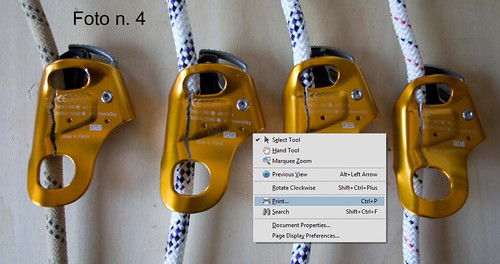Google Translate:
During the experimental research carried out in the laboratories of the GLM Costacciaro, with slow tensile tests (vd = 0.005 s-1) and fall (vd = 4,429 s-1) were tested several blockers ventral cords applied to new and used.
Everyone has given excellent results reported with the exception of the Petzl Croll put on sale starting from January 2013 (photo no. 1) that it broke even with loads of just 500 kgp, making reverse the ratchet and escape the rope, without tearing the sheath and begin the process of energy absorption related to the sheath slippage on strands interiors (photo n. 2-3).
The specimens examined (bought in a sporting goods store with regular invoice, in original packaging) are identifiable by their acronyms are described in the ratchet.
The Petzl Croll 2013 differs from the previous model:
1.
a plate with reduced thickness of about 1 mm,
2.
a protective steel inside the throat of slip of the rope,
3.
the absence of a system of tilt of the ratchet.
The most marked effects occurred at slow traction (vd = 0,005 s-1) with forces between 400 and 600 kgp kgp, with the breaking of the back of the tool, the opening of the throat, the overturning of the ratchet and spill rope (photo n. 4-5).
In some cases the throat did not open completely, the ratchet albeit slightly not rolled over,
the shield is broken, but immediately after the ratchet strangled to the point where the strands to break
all in no time. Has not triggered any phenomenon of energy dissipation with
sheath slippage on the soul of the rope.
In tests in fall (vd = 4,429 s-1) the throat does not
is open and the ratchet is not overturned, but
after breaking of the sock all the strands were
sheared the rapid succession. In these cases the
blocker is unusable as the result
throat is open by a few millimeters and the rope
was able to escape with a minimum tensile
transverse.
The deformation of the throat also occurs with
small stresses (300 kgp - 400 kgp) to
result of which is a measure opening
Additional few tenths of a millimeter.
Added to other similar solicitations
the opening of the throat continues to increase.
The results listed above were obtained on
following strings:
1. Beal Antipodes New 10 mm (static)
2. Beal Antipodes 10 mm Used (static),
3. Edelrid SS 10 mm Used (static)
4. Last Courant New 10 mm (static)
with strands glued inside the
stocking,
5. Last Courant New 11 mm (static)
with strands glued inside the
stocking.
The worst results have occurred with the strings Last Courant (braid bonded to the strands) and, above all,
with the strings used (most common state in the progression in the cave).
For all this I think that the Petzl Croll 2013 as a blocker that should be used with extreme caution, with frequent observations of his condition and replace if it can suffer a solicitation of more than 400 kgp. It should also be very careful on the rise in splits with pitches very moved, however, whenever the length of rope downstream of the cross-blocker exerts traction.
In contrast, a Petzl Croll product before (recognition code 10266FU8865, then produced in the 266 th day of 2010), with rollover of the ratchet (photo no. 6) resulted in an exceptionally durable and reliable tool that has endured numerous tests, with stress to the limit, without showing deformation and structural failure.
E 'was also tested at a slow loading Petzl Croll without tipping the ratchet product in the eighties of the past century: with a maximum stress of 600 kgp rolled over the ratchet and release the rope to the enlargement of the throat (photo . 7). Behavior almost similar to that of Croll, 2013, with the only difference that the back is not fractured.
I believe that the main causes that determine the behavior of the model 2013 Petzl Croll are to be found in the reduced thickness of the plate and in the absence of the system "rollover" of the ratchet.
Costacciaro April 18, 2013







